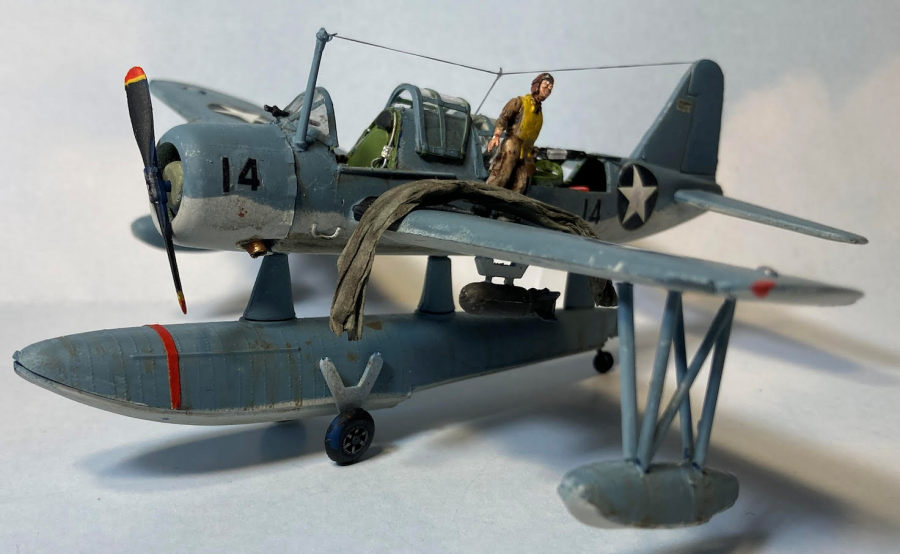
| KIT #: | 251 |
| PRICE: | $5.00 'used' |
| DECALS: | Two options |
| REVIEWER: | Joe Essid |
| NOTES: | 2018 tooling |

| HISTORY |
"Essid! Smoke break! Get over here!" My dad slung the M-1 Garand on his shoulder and walked to the CPO. He figured he'd be shelling out the 10 bucks lost by betting on himself at the boxing match, where a big Polish guy from Chicago took him out in the first round.
"Chief, what's up?" They'd been on casual terms since dad escorted without incident a group of German POWs, Afrika Corps vets fresh from the Brits, sent to do farm work around Hampton Roads. One German had said that my dad threatened to shoot him with a .45, but dad reported that it was exaggerated. He stopped to relieve himself on a long march and didn't want the POWs he was herding down a sandy road to stop or turn around.
The CPO tapped a Lucky out of the box, lit the cigarette, then offered dad one. "Topside asked me to find the right man for this job. We need you to get a detail together to watch Hanger 2. Some tough SPs who worked with you before. Marksmen only. We got a bunch of new amphibians in to patrol for U-Boats as soon as we repaint them. There might be spies who want to burn the place down. You heard about the guy climbing the fence last week, we arrested? From now on, anyone unauthorized, in uniform or not, will get one verbal warning and one warning only."
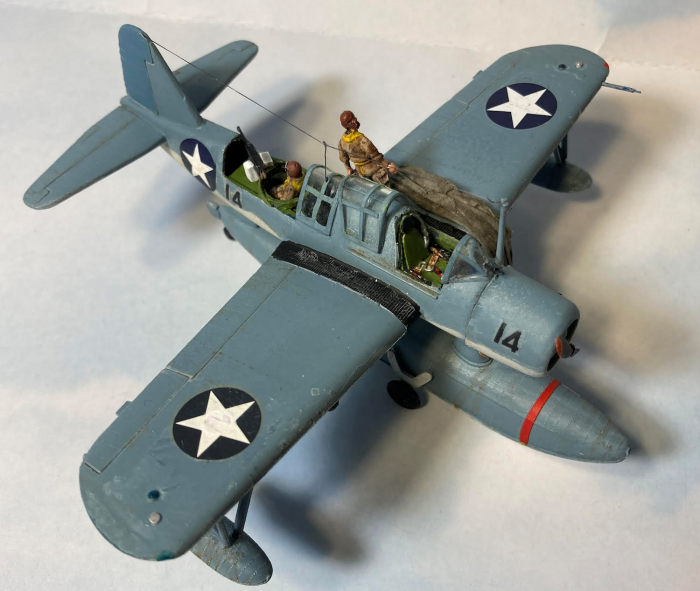 Dad knew the
rest, but that was not why he got a lump in his throat. On his last leave, he'd
watched as a merchantman burned off Virginia Beach. Planes and escort vessels
raced to find the sub, too late to save the ship or one of the crew.
Dad knew the
rest, but that was not why he got a lump in his throat. On his last leave, he'd
watched as a merchantman burned off Virginia Beach. Planes and escort vessels
raced to find the sub, too late to save the ship or one of the crew.
"One more thing, Essid," the Chief said as dad got ready to return to his post. "How's your painting skills? Need you boys to get these planes ready. Bigger insignia, paint over any meatballs and tail stripes. Get them ready fast. Perfect can wait."
Dad nodded with a frown. He hated painting and in the Navy: if it moved, salute it, if it didn't paint it. He'd stupidly saluted a CPO right out of training and got a dressing down for it as well as job painting a barracks.
"Sure thing, Chief." "Now get back to post. Don't salute me, don't paint me, and get me that 10 tomorrow, okay?" It was true. Chiefs could read minds.
Now the real history: The Kingfisher remains a largely unsung hero of WW2, where it served from start to finish in the role of gunnery-spotter for cruisers and battleships, briefly and not very well on destroyers. They worked as patrol aircraft for subs and surface raiders; they earned a sterling reputation as rescue aircraft saving many lives.
Their saves included WW 1 ace Eddie Rickenbacker, on an inspection tour in November 1942, when he and the crew in a B-17 made a water landing. After 24 days at sea and some harrowing experiences, the survivors were rescued by a Kingfisher, as described in Rickenbacker's 1943 memoir of, Seven Came Through.
I'll refer readers wanting more to Brian Baker's excellent builds, here at MM.
| THE KIT |
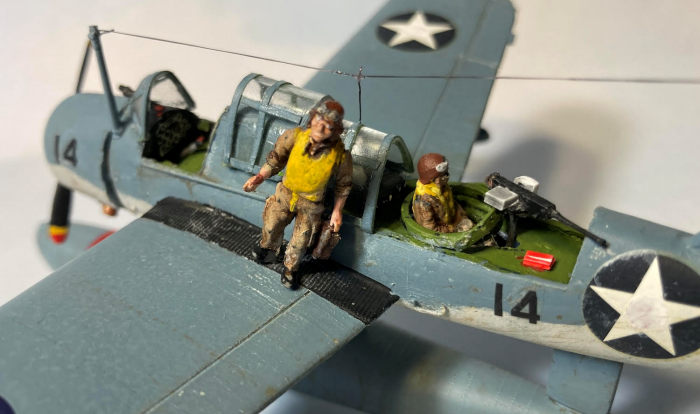 My dad's
story about the POWs, the boxing match, and the merchantman he saw attacked are
all true. I also figured that my father saw lots of Kingfishers during his time
as an SP in Norfolk. I've long loved the plane (and all sea planes or
amphibians) so I wanted one in my preferred scale.
My dad's
story about the POWs, the boxing match, and the merchantman he saw attacked are
all true. I also figured that my father saw lots of Kingfishers during his time
as an SP in Norfolk. I've long loved the plane (and all sea planes or
amphibians) so I wanted one in my preferred scale.
I spotted this kit among other vintage Airfix and Heller kits at a Petersburg, VA antiques dealer. I snapped it and a Grumman Duck up for $5 each. They appear on eBay for a bit more, plus the shipping I didn't pay in person.
Opening the box reveals over 50 parts molded in dark blue and very thick canopies. The box is tiny, which helped keep things from being damaged, though the DF Antenna loop was broken and several other parts had come loose from the sprues and were rattling around.
| CONSTRUCTION |
Parts fit really well, perhaps because this model comes from when the molds were new. The raised panel-lines were faint, and they don't distract from the model. I used only a little CA filler on the bottom seam, when I attached the center float.
I usually wash old kits in soapy water, but this time Edgar Allan Poe's "Imp of the Perverse" got me. Channeling my inner 12-year-old, I just started building. I think I wiped the cockpit walls in rubbing alcohol before brush-painting them Model Master interior green. I scratch-built some side panels for the cockpit, added a floor, and made seat belts out of masking tape, with bits of jeweler’s wire for buckles. I added a lift cable that coils around the pilot's seat in the real aircraft, fabbed from really tiny metal cable, a loop of jeweler’s wire and a collar of HVAC silver tape. the control panel comes from the decal dungeon, and I drilled a hole in the windscreen for a gun sight made from a bit of stretched sprue.
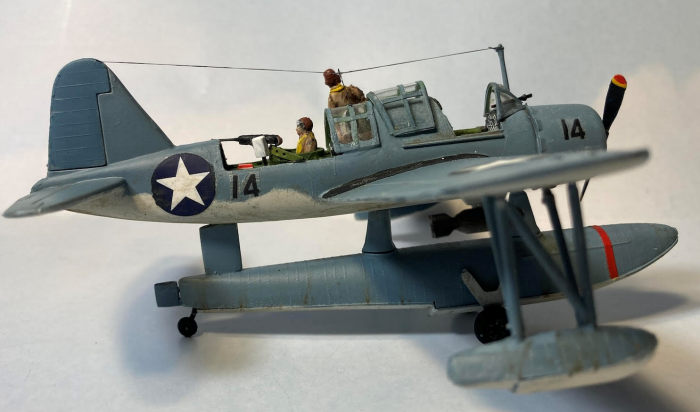 The Airfix
kit's weak spot, yet most interesting for scratch-building, is its
gunner/observer compartment. In the end, this rear compartment became a
mini-diorama. It was certainly my favorite part of the build.
The Airfix
kit's weak spot, yet most interesting for scratch-building, is its
gunner/observer compartment. In the end, this rear compartment became a
mini-diorama. It was certainly my favorite part of the build.
I tossed the upper torso supplied for a gunner and painted up the Airfix pilot to fill the void. Next I used a thin Evergreen strip, with some holes drilled out, for the ring in the observer/gunner's station, to hold a scratch-built a .30 rear gun made with bits of styrene and stretched sprue. I also added a tiny screw-eye for the DF loop. A life-raft of paper towel, soaked in slightly thinned white glue then painted yellow, filled the void in front of the radio and loop. A period photo revealed a first-aid kit near the gunner, so I made one and painted it red with a little white stripe. under each seating position, I added using jeweler's wire the OS2U's distinctive loop steps for boarding.
The kit's thick glazing would not fit over the DF Loop, so I formed a piece from plastic packaging. It sits proud of the fuselage, but the pilot I pose on the wing covers that particular sin.
I contemplated putting a half-rolled OD tarp to cover the flaw, thereby tricking the eye, as my painting teacher used to say, plus adding some more detail. In the end I let it be. The tarp, made with paper towel soaked first in Mission OD paint, then in the 10% white-glue solution I use on fossils I've collected, drapes over a wing for some swab to remove before the plane's next flight.
The only tricky part of my build involved the wingtip floats. I stupidly forgot to drill out all four holes on one side. On the other, I broke the float off while handling the kit. After a good bit of measuring and removing an underwing insignia that I'd placed too close to the struts, I got the small, spindly legs for the wingtip floats looking half way decent. The mistake shows in photos, but not in the case. As as a colleague at work says, "do not let perfect be the enemy of good."
| COLORS & MARKINGS |
Originally I planned one for my 1/72 Midway collection, but no Kingfishers were deployed on the cruiser escort for Spruance's carriers. I began to think of something contemporaneous, when my dad's duty around NAS Norfolk sprung to mind as a family "might have been."
Brian Baker's build of the Airfix kit is nigh exhaustive in the varieties he produced, but I don't see one in the transitional color scheme of Spring and early Summer 1942, so I chose to model mine on a plane my dad may have seen during his time as an SP.
Mission Intermediate Blue and Camo Gray got airbrushed over white Mission primer, after filling and sanding out imperfections. In an earlier build I'd noted how easily Mission paints smear even after a top coat of gloss, before decaling. This time I added some of their poly additive to the paints, and they sprayed on and held well when I brushed on Future for decaling. I did thin the paint a bit with Mission thinner to be sure my Badger Patriot would give a good flow. I next darkened slightly the Mission Blue and brushed it over the rudder, where the prewar stripes would have been.
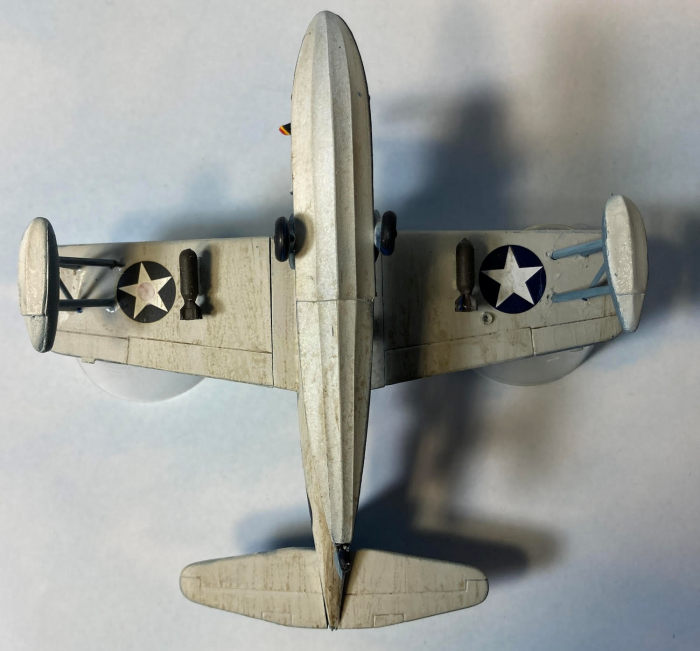 I have a
tough time restraining myself when it comes to weathering aircraft. In this
case, I did my best to keep the plane looking relatively fresh, with some Flory
Grime streaks down the floats and along the bottom of the plane and a bit of
their black in the few recessed lines on the model. Squadron's Guide to the OS2U
notes that Navy crew painted their amphibians frequently, to keep corrosion at
bay. The waters of a Navy yard are not the cleanest in the world, so I figure
even fresh paint would get dirty fast and fade from salt water. I worked over
the wing-walks with Prismacolor silver but kept chipping minimal. The supplied
exhausts looked really awful, so replacement were cut from brass rod, dipped in
Model Master Leather enamel (close enough to rust), then washed with Flory
black.
I have a
tough time restraining myself when it comes to weathering aircraft. In this
case, I did my best to keep the plane looking relatively fresh, with some Flory
Grime streaks down the floats and along the bottom of the plane and a bit of
their black in the few recessed lines on the model. Squadron's Guide to the OS2U
notes that Navy crew painted their amphibians frequently, to keep corrosion at
bay. The waters of a Navy yard are not the cleanest in the world, so I figure
even fresh paint would get dirty fast and fade from salt water. I worked over
the wing-walks with Prismacolor silver but kept chipping minimal. The supplied
exhausts looked really awful, so replacement were cut from brass rod, dipped in
Model Master Leather enamel (close enough to rust), then washed with Flory
black.
Decals came from an old Poly S set for Kingfishers and Grumman Ducks. I painted over the meatballs on these but then destroyed two of the insignia that were either crooked or, on one wing, misplaced. I found extras in my decal dungeon, one of which got ruined (though over coated with flat) by some masking tape. Its under-wing replacement is slightly larger than the surviving Poly-S decal, which actually suits me. Some images in Squadron's guide clearly show aircraft wearing mismatched insignias. Early-to-mid 1942 was no time for spit-and-polish aircraft serving off the Atlantic Seaboard or in the Pacific.
I posed a pilot on the wing, from an CMK set of Pacific theater USN pilots, put on EZ-line antennae, managing somehow to get the things stuck down on the first go, glued on the kit's 100lb bombs, and called the Kingfisher done. Photos reveal lots of remaining boo-boos but so be it. Cameras never lie, but the right lighting works wonders. Once again, "do not let perfect be the enemy of good." In the case the OS2U looks good beside my other Navy birds from 1942.
Perfect can wait for the next build. Now I only need a burly 1/72 SP figure of my dad to watch over the kit.
| CONCLUSIONS |
With help on the wingtip floats, a child could build this kit OOB. Novices can tackle it, but with some scratch-building and persistence, a nice model will emerge from the antique kit. It was a joy to build and now I want more Kingfishers, maybe a yellow-wing bird and a Fleet Air Arm aircraft. Then there's the Australian OS2U that went to the Antarctic...
| REFERENCE |
Adcock, Al. OS2U Kingfisher in Action. Carrollton, TX: Squadron-Signal, 1991.
US Naval Institute, "When War Erupted Off Virginia Beach." https://www.usni.org/magazines/naval-history-magazine/2022/june/when-war-erupted-virginia-beach
14 November 2023
Copyright ModelingMadness.com. All rights reserved. No reproduction in part or in whole without express permission from the editor.
If you would like your product reviewed fairly and fairly quickly, please contact the editor or see other details in the Note to Contributors.